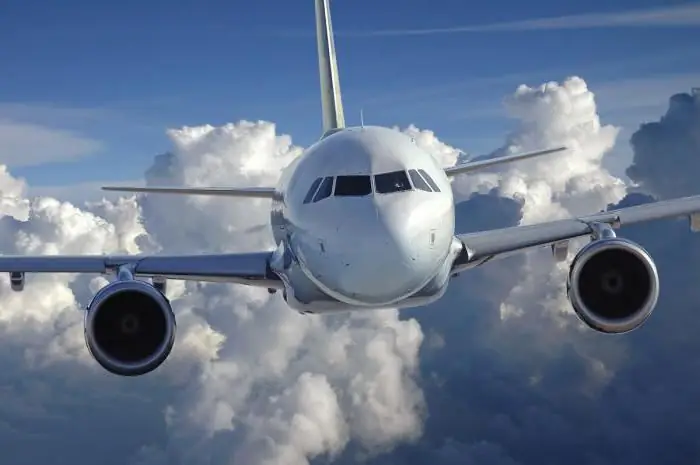- Author Harold Hamphrey [email protected].
- Public 2023-12-17 10:06.
- Last modified 2025-06-01 07:20.
The Boeing 767-200 is a wide-body aircraft designed for medium and long flights. This type is most often used on transatlantic flights.
History of Creation
"Boeing 767-200" - one of the developments of the American company The Boeing Company. The airliner began to be developed in parallel with another modification - the Boeing 757
In 1972, the company began research on a new 7X7 aircraft with 200 seats in the passenger cabin. It was assumed that this model would become a transitional type between the Boeing 727-200 and wide-body airliners of the L-1011 and DC-10 types, and in terms of flight performance it would compete with the Airbus A300 and A310.

When developing the design, the economy of the aircraft was of no small importance, since it was during these years that the price of kerosene increased sharply.
However, the Boeing 767 program officially started only in 1978. Flight tests began to be carried out only in 1981. After two years, the company received a certificate for the production of aircraft of this type with JT9D-7R4D and CF6-80A engines. Initially, aircraft designers conducted research on three variants of aircraft of this type, designed to carry 180, 200 and 220 passengers. But finally the choice was stopped on modification 767-200.
The first carrier to order these aircraft was United Airlines. The commissioning of the first airliner took place in August 1983.
In 1998, The Boeing Company announced the start of a project to convert a passenger 767-200 into a freighter with the assignment of an index of 767-200 SF.
For the entire period of production of this model, 128 aircraft were handed over to customers, and all requests for the supply of 767-200 were fully completed.
Principal differences
Boeing 767-200 differs from other aircraft of its generation by a high degree of efficiency and the use of the latest technological solutions in the manufacture. This modification became the basis for a new family of Boeing wide-body long-haul aircraft, including the 767-300 and the cargo version - 767-300 F.

This aircraft is designed for medium to long haul flights with larger fuel tanks.
The cockpit is equipped with EFIS digital avionics (manufactured by Rockwell-Collins) with 6 multifunctional color screens.
Specifications
- Wingspan - 47.57 m.
- Length - 48.51 m.
- The maximum width of the fuselage is 5 m.
- Height - 15.85 m.
- Empty air weightvessel - 81 t.
- Maximum takeoff weight - 143 t.
- Engines - two units JT9D-7R4D, PW4050, CF680C2B4F or CF680C2B2.
- Maximum speed is 967 km/h.
- Speed at flight level - 910 km/h.
- The maximum flight altitude is 13 km.
- Maximum permissible flight range at full load - 6800 km.
- The required runway length is 1980 m.
- Maximum passenger load is 216 people in 2 classes of service.
Salon Features
The main difference between the Boeing 767-200 airliner is the interior. For passengers flying in the economy class, seating is provided in one row of seven people, two people near the windows, three people in the middle. Studies have shown that this seating arrangement is the most optimal and meets the needs of passengers.

The interior of the airliner was designed to the comfort standards set during the development of the world's first wide-body aircraft, the Boeing 747.
The Boeing 767-200 is one of the most reliable airliners in the world. It also has the name "Gimli glider", which was obtained as a result of one of the famous aviation accidents. The fuel ran out at an altitude of more than 8 km, but despite this, the plane flew another 20 km and landed at Gimli airport.
Many carriers in Australia, Europe, North America and Asia have Boeing 767-200s in their fleets. Transaero and UTair are Russian airlinesof this number.






